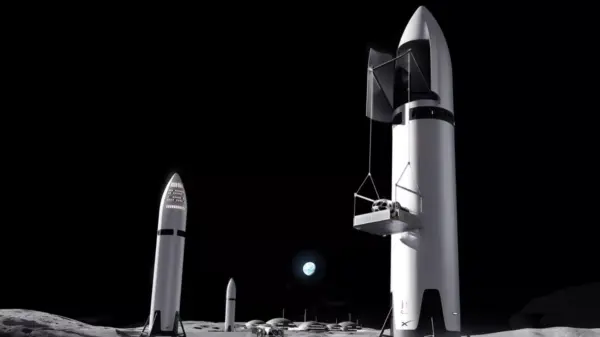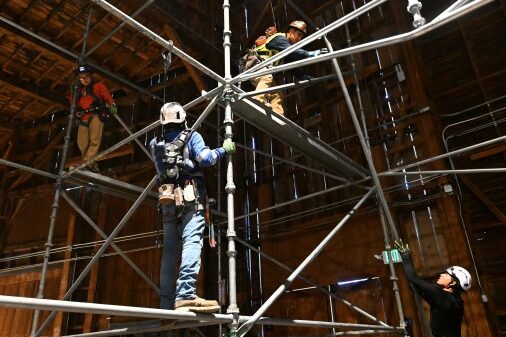NASA’s Escape and Plasma Acceleration and Dynamics Explorers (ESCAPADE) mission is set to launch on November 9, 2025, from Cape Canaveral Space Force Station. The mission will utilize Blue Origin’s New Glenn rocket, marking a significant step in space exploration. This mission aims to send two Mars-bound satellites, named “Blue” and “Gold,” into orbit, alongside a communications demonstration payload for Viasat.
The New Glenn rocket, measuring 321 feet (98 meters) tall, is scheduled for liftoff during an 88-minute window that opens at 14:45 EST (19:45 UTC). Blue Origin aims to achieve a south-easterly trajectory as it departs from Launch Complex 36. Live coverage of the launch will begin approximately two hours before liftoff, as reported by Spaceflight Now.
The 45th Weather Squadron has indicated a 65 percent chance of favorable weather at the start of the launch window, although this likelihood decreases to 55 percent later. Meteorologists have expressed concerns regarding cumulus clouds and potential thunderstorms, as a cold front approaches from the northwest. Launch weather officers have cautioned that strong thunderstorms may develop, leading to wind gusts near 80 feet per second.
Blue Origin will also attempt to land the first-stage booster, named “Never Tell Me the Odds,” on its autonomous barge, Jacklyn. This booster, standing at 188 feet (57.4 meters), will initially utilize three BE-4 engines, transitioning to a single engine for the final landing burn. Should the recovery be successful, the company plans to reuse this booster for its third flight. In a social media update, CEO Dave Limp reassured followers that the company is prepared for any outcome, stating, “We’ve got several more New Glenn boosters already in production.”
This launch represents the first time Blue Origin’s orbital-class rocket will carry payloads for customers. The ESCAPADE spacecraft were encapsulated in the rocket’s 23-foot-diameter (7 meters) payload fairings on October 31, 2025. After liftoff, the rocket’s upper stage will perform two burns of its BE-3U engines before deploying the twin satellites approximately 33 minutes into the flight. The Viasat demonstration will activate roughly five minutes after the second satellite is released.
The launch is being coordinated by NASA’s Launch Services Program at Kennedy Space Center under the Venture-Class Acquisition of Dedicated and Rideshare (VADR) launch services contract. The overall contract holds a maximum total value of $300 million over a five-year period. Initially scheduled for late 2024, the ESCAPADE mission was delayed due to the New Glenn rocket’s readiness timeline.
The ESCAPADE mission is led by NASA’s Goddard Space Flight Center in collaboration with the University of California, Berkeley, Space Science Laboratory, Rocket Lab, and other institutions. The two spacecraft will work in tandem to study Mars’ magnetosphere and its response to space weather, providing crucial insights into the planet’s climatological history and atmospheric loss.
Joseph Westlake, NASA Heliophysics Director, expressed excitement about the mission, stating, “Really excited to see (NASA’s) Heliophysics’ first mission to Mars and being able to deliver that space weather information that will hopefully help as humanity expands out into the cosmos.”
Originally conceived as the Mars Ion and Sputtering Escape Network (MISEN) in October 2016, the project evolved into ESCAPADE by July 2018. NASA selected it as one of three finalists for its Small, Innovative Missions for Planetary Exploration (SIMPLEx) program in June 2019. This program encourages missions with a higher risk tolerance and shorter timelines.
Rocket Lab, which constructed the twin spacecraft, completed the assembly at its Spacecraft Production Complex in Long Beach, California. The entire process for developing the two satellites was notably rapid, taking only three and a half years. Christophe Mandy from Rocket Lab noted, “A typical timeline for a Mars mission is a decade,” underscoring the efficiency of the ESCAPADE project.
The spacecraft, designed to remain in Earth orbit for approximately one year, will then begin a 10-month journey to Mars. This trajectory was adjusted due to the launch delay exceeding a year. The Mars orbit insertion burn is anticipated in September 2027, with a subsequent science mission scheduled from June 2028 until May 2029.
As the launch approaches, anticipation builds for this critical mission to advance our understanding of Mars and the broader cosmos.





































































